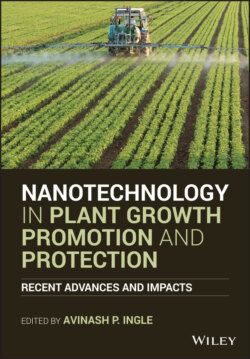Читать книгу Nanotechnology in Plant Growth Promotion and Protection - Группа авторов - Страница 49
3.2.2 Effects of Zn NPs on Seed Germination
ОглавлениеZn plays a critical role in the production and activation of germination enzymes (digestive and antioxidant enzymes) and hormones (auxin and gibberellin) that improve seed germination and seedling growth (Broadley et al. 2007). Seedling in Zn NPs suspension requires low Zn NPs concentration (<100 mg/L) for better seedling growth. Awasthi et al. (2017) found optimum effects on germination and seedling growth in wheat is germination at 50 mg/L ZnO NPs (9 nm) suspension. Zn NPs were found to be more dose effective in the case of smaller seeds like cabbage, onion, and lupine (Table 3.1). Pokhrel and Dubey (2013) examined the difference between the effects of ZnO NPs on cabbage and maize seed germination. The results obtained indicated that cabbage seeds with smaller size and more surface area to volume ratio are more vulnerable to the negative effect of ZnO NPs. They also reported that concentrations higher than100 mg/L showed a significant negative effect in cabbage seed germination. Whereas, in the case of maize, ZnO NPs showed positive effects in seed germination up to 500 mg/L. Raskar and Laware (2014) reported that ZnO NPs enhanced onion seed germination only at a concentration lower than 20 μg/mL. Similarly, Latef et al. (2017) found that ZnO NPs at 60 mg/L showed positive effects on lupine seed germination and seedling vigor. However, high concentration Zn NPs treatment to small size seeds for a long time period can be toxic. Black mustard grown at 500 mg/L ZnO NPs treated plain agar media for 12 days showed negative effects on germination and seedling growth (Zafar et al. 2016). Seed growth media also impact the dose efficiency and toxicity of Zn NPs. According to Thunugunta et al. (2018), 100 mg/L ZnO NPs (35 nm) showed positive effects on eggplant seed germination when amended to soil; however, concentration as little as 5 mg/L showed adverse effects when applied through Murashige and Skoog (MS) media. Table 3.1 shows the effects of Zn NPs on germination and seedling growth after application through different modes.
Figure 3.1 Outline of different methods used for the treatment of seeds with Zn NPs and their effects.
Table 3.1 Effects of Zn NPs on germination and seedling growth after application through different modes.
| Size and coatings (nm) | Crop | Concentrations | Mode of application | Effects | References | ||
|---|---|---|---|---|---|---|---|
| Root growth | Shoot growth | Germination percent | |||||
| 21.3 | Lupine | 20, 40, and 60 mg/L | Seed priming (12 hours) under salt stress (150 mM NaCl) | + | + | + | Latef et al. (2017) |
| 20 | Onion | 10 and 20 mg/L | Seed treatment in petri‐plate for 10 days | + | + | + | Raskar and Laware (2014) |
| 30 and 40 mg/L | Seed treatment in petri‐plate for 10 days | − | − | − | |||
| 25 | Peanut | 400 and 1000 mg/L | Seed treatment (3 hours) | + | + | + | Prasad et al. (2012) |
| 2000 mg/L | Seed treatment (3 hours) | − | − | − | |||
| 25 | Maize | 50–2000 mg/L | Seed soaking (3 hours) | + | + | + | Subbaiah et al. (2016) |
| <100 | Brassica | 500–1500 mg/L | Seed allowed to grow in treated plain agar for 12 days | − | − | − | Zafar et al. (2016) |
| <100 | Wheat | 500 mg/L | Seed treatment (24 hours) | + | + | + | Elhaj Baddar and Unrine (2018) |
| n/a | Rice | 500 and 750 mg/L | Seed treatment till germination | − | − | − | Sheteiwy et al. (2017) |
| 30–60 | Rice | 5, 10, 15, 20, and 50 mg/L | Seed soaking (1 hour) | + | + | + | Panda (2017) |
| 34 | Wheat | 25, 50, 75, and 100 mg/L | Seed priming (24 hours) | + | + | + | Munir et al. (2018) |
| 13 | Wheat | 10, 20, and 50 mg/L | Hydroponic supplement (14 days) | + | + | + | Awasthi et al. (2017) |
| 100 mg/L | − | + | − | ||||
| 20, 40, and 60 | Common Bean | 1, 10, 100, and 1000 mg/L | Seed priming (20 minutes) | + | + | o | Savassa et al. (2018) |
| 5000 mg/L | − | − | − | ||||
| 18 | Capsicum | 100, 200, and 300 mg/L | Applied during imbibition (72 hours) | + | + | + | Israel García‐López et al. (2018) |
| 400 and 500 mg/L | − | − | − |
